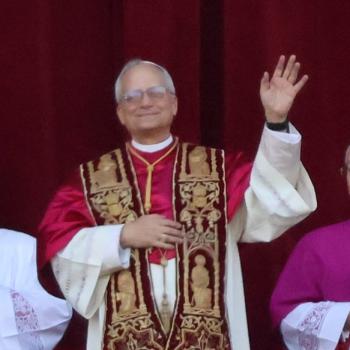Lectionary Reflections
Exodus 34:29-35
February 7, 2016
It is once again Transfiguration Sunday, one of the spookier days of the Christian year. Too bad this day does not fall closer to Halloween; I can imagine that our more inspired mercantile entrepreneurs might make some financial hay from such a day. How about some greeting cards with a pleasant Jesus on the cover and a glowing one on the inside with a booming voice saying, as one opens the card, "Listen to him, for God's sake!" (That is a slight paraphrase from Luke's version of the scene at Luke 9:35.) Or a Jesus action figure with a normal face that alters to a bright glowing one when he is squeezed? One could add to that a tableau of a grisly Elijah on one side and a full-bearded Moses on the other who then disappear at the press of a button hidden on Jesus' back. Perhaps a sleepy, and then creeped-out disciple or two could complete the picture. How about this year, in addition to the live nativity at Christmas, why not a live transfiguration to amaze the adults and scare the kiddies — scare into faith, I mean, of course.
It seems rather obvious that the transfiguration scenes from the gospels (Matthew and Mark have one, too) are somehow based on or at least show some parallels to the strange scene toward the end of the book of Exodus when Moses comes back from his return trip up Sinai with the restored commandments of YHWH in his hands, referred to here as the "two tablets of the treaty" (or "covenant" or "testimony," Ex. 34:29). The tablets are not named the bearers of the Ten Commandments, but the tablets of the covenant, an unusual designation.
But despite that formulation, the scene does not focus on the tablets, unlike the earlier scene in Exodus 32 where Moses' return from his chat with YHWH engenders the destruction of the first tablets in sight of the abominable molten calf and the appalling behaviors that its creation has caused. The eyes of the reader there are fixated on the pile of shattered pieces of the holy gift YHWH has given, a pile that brings cries of horror from the Israelites and a weaseling and hilarious series of lies from the priestly mouth of Aaron, the actual creator of the calf.
But in Exodus 34 the tablets receive only the one very brief and decidedly peculiar glance. The eyes of the reader of this scene are drawn directly to Moses' face and are fixed there throughout the episode. The concern is with the odd and mysterious glow that emanates from the prophet's visage after he has been talking with YHWH. I mentioned before in my earlier article on this passage that the verb now translated "glow" is based on a verb that more commonly is read as "horn." Thus earlier readers read the verse, "The skin of Moses' face was horned when he talked with him." The Vulgate Latin translation of Jerome translated quite directly the Latin for "horn," and as a result the great Michelangelo sculpture of Moses, still to be seen in the portico of St Peter's cathedral in Rome, is festooned with horns. But it is now abundantly clear that "glow" or "ray" is the proper reading.
So what? Why should I be concerned about that nicety of correct translation? The scene remains even with that confusion untangled decidedly peculiar. "When Aaron (odd to find the bold-faced liar of Ex. 32 back in the scene) and all the Israelites saw Moses, the skin of his face glowing, they were terrified to come near him" (Ex. 34:30). I suppose that makes sense; YHWH has had a physical effect on the prophet, and everyone can see it. He has been set apart from the rest of them, and they are patently afraid to get close to the shining man. One can hardly blame them!
"But Moses called to them, and Aaron and all the leaders of the community (note: not all Israel yet) returned to him, and Moses spoke with them" (Ex. 34:31). If I read the picture aright, Aaron, still in some sense a leader in the community, along with a few other leaders, unnamed, carefully creep back in the direction of Moses, only close enough where he can be heard. When it appears that the glowing man does not obliterate their leaders with the power of his shining, the remainder of "all Israel came near, and he commanded them all that YHWH had spoken with him on Sinai" (Ex. 34:32). In some more traditional Jewish communities, this is the sentence that they repeat to insist that all 613 laws were provided to Judaism through Moses's words directly from Mount Sinai, not merely the Ten Commandments.
"When Moses has finished speaking with them, he put a veil over his face," and the question is why? The word used here, rendered "veil," is only found in this verse in the entire Bible. Hence, we are on our own to try to interpret just what is going on. If the veil (a cultic mask of some sort?) was used by Moses to protect the people from his divinely glowing face, one could imagine that he would have put it on before he began to relay to them what YHWH had said. That is clearly not what happens; he puts it on after the speech, not before. He only takes it off when he speaks with YHWH, when he "goes in before YHWH," presumably into the tent of meeting, that moveable sanctuary that we are later told is only available for the great Moses to have his time with YHWH. And when he exits the tent and his speaking with YHWH has ended, "he would put the veil on his face again" (Ex. 34:35). So at the end of the episode, it appears that the glowing Moses no longer allows his face to be unveiled in the presence of the people but only in the presence of YHWH. This masking and unmasking is very confusing, since what we expect does not happen, as far as I can tell.





